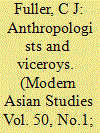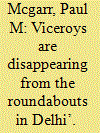|
|
|
Sort Order |
|
|
|
Items / Page
|
|
|
|
|
|
|
| Srl | Item |
| 1 |
ID:
144220


|
|
|
|
|
| Summary/Abstract |
The anthropology of caste was a pivotal part of colonial knowledge in British India in the late nineteenth and early twentieth centuries. Denzil Ibbetson and Herbert Risley, then the two leading official anthropologists, both made major contributions to the study of caste, which this article discusses. Ibbetson and Risley assumed high office in the imperial government in 1902 and played important roles in policy making during the partition of Bengal (1903–5) and the Morley-Minto legislative councils reforms (1906–9); Ibbetson was also influential in deciding Punjab land policy in the 1890s. Contemporary policy documents, which this article examines, show that the two men's anthropological knowledge had limited influence on their deliberations. Moreover, caste was irrelevant to their thinking about agrarian policy, the promotion of Muslim interests, and the urban, educated middle class, whose growing nationalism was challenging British rule. No ethnographic information was collected about this class, because the scope of anthropology was restricted to ‘traditional’ rural society. At the turn of the twentieth century, colonial anthropological knowledge, especially about caste, had little value for the imperial government confronting Indian nationalism, and was less critical in constituting the Indian colonial state than it previously had been.
|
|
|
|
|
|
|
|
|
|
|
|
|
|
|
|
| 2 |
ID:
139688


|
|
|
|
|
| Summary/Abstract |
In the aftermath of the Second World War, as post-colonial regimes in Africa and Asia hauled down imperial iconography, to the surprise and approval of many Western observers, India evidenced little interest in sweeping away remnants of its colonial heritage. From the late 1950s onwards, however, calls for the removal of British imperial statuary from India's public spaces came to represent an increasingly important component in a broader dialogue between central and state governments, political parties, the media, and the wider public on the legacy of British colonialism in the subcontinent. This article examines the responses of the ruling Congress Party and the British government, between 1947 and 1970, to escalating pressure from within India to replace British statuary with monuments celebrating Indian nationalism. In doing so, it highlights the significant scope that existed for non-state actors in India and the United Kingdom with a stake in the cultural politics of decolonization to disrupt the smooth running of bilateral relations, and, in Britain's case, to undermine increasingly tenuous claims of continued global relevance. Post-war British governments believed that the United Kingdom's relationship with India could be leveraged, at least in part, to offset the nation's waning international prestige. In fact, as the fate of British statuary in India makes clear, this proved to be at least as problematic and flawed a strategy in the two decades after 1947 as it had been in those before.
|
|
|
|
|
|
|
|
|
|
|
|
|
|
|
|
|
|
|
|
|